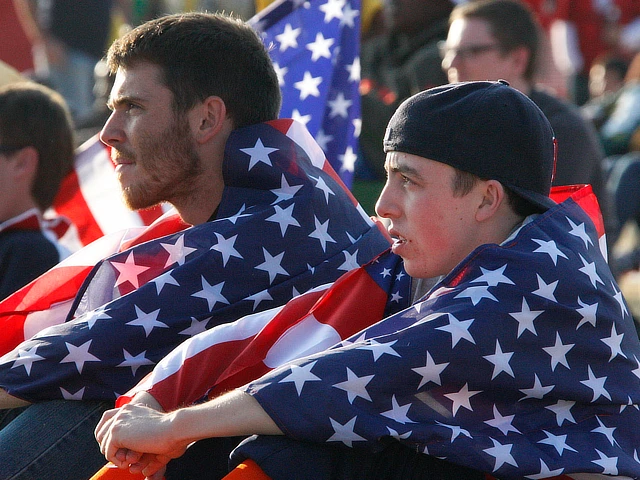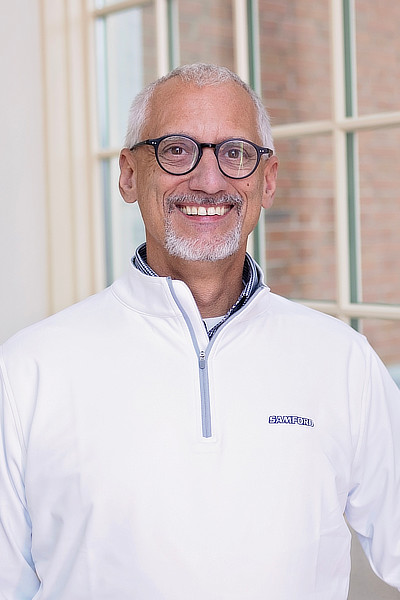
"USA Soccer Fans" by babasteve is licensed under CC BY-SA 2.0.
Major Study Will Track American Fans Through 2026 FIFA World Cup to Answer: Why Isn't Soccer More Popular in the U.S.?
For decades, the sports industry has grappled with a persistent question: Despite hundreds of millions of dollars and multiple World Cups on American soil, why hasn't soccer achieved mainstream status in the United States and what will it actually take to make that happen? As the nation prepares to co-host the 2026 FIFA World Cup in 8 months, Samford University's Center for Sports Analytics today announced a comprehensive longitudinal study that aims to answer this question.
The research, led by Dr. Darin W. White, Executive Director of the Center for Sports Analytics and Margaret Gage Bush Distinguished Professor at Samford, will test what researchers call the "4P Soccer Passion Model", a framework for understanding how Americans develop sustained engagement with soccer, developed through years of student-led research projects examining fan behavior across Fortune 500 brands, U.S. soccer organizations, and international clubs seeking to grow their American fanbase.
The Decades-Long Conundrum
The challenge of making soccer a permanent fixture in American sports culture had puzzled industry leaders for a long time, even before the 1994 World Cup. Despite massive investments in youth development, the creation of Major League Soccer, high-profile international player acquisitions, and broadcast deals worth millions, soccer remains what many consider a "niche" sport in America. The sport has struggled to break into the year-round mainstream sports conversation, which is dominated by the NFL, NBA, MLB, NHL, and college sports.
"This isn't just an academic question," said Dr. White. "Leagues, teams, broadcasters, and sponsors have invested enormous resources trying to crack the code of American soccer fandom. The 2026 World Cup represents perhaps the greatest opportunity in history to understand what actually converts casual interest into permanent passion. Our study will provide the data-driven insights the industry has needed for decades."
Years of Student Research Leading to the 4P Soccer Passion Model
Over the past decades, students at Samford's Center for Sports Analytics have conducted research projects examining various aspects of this conundrum. These student-led projects have involved analyzing fan behavior for Fortune 500 brands that sponsor soccer, U.S. soccer teams at multiple levels, and international clubs from the Bundesliga, English Premier League, and Scottish Premiership, with the goal of understanding and expanding their American fan base.
"Each project approached the question from a different angle—consumer behavior, social media engagement, viewing patterns, merchandise purchases, attendance drivers," Dr. White explained. "But over time, common patterns began to emerge. Americans weren't engaging with soccer in the same way they did with the Big Four sports. There was a distinct progression, a pipeline if you will, that fans moved through. That's when we began synthesizing these findings into a comprehensive framework."
The result is the 4P Soccer Passion Model—Pipeline for Producing Permanent Passion—which describes four distinct stages through which Americans typically progress as they develop sustained engagement with soccer. The model challenges conventional assumptions about how soccer fandom develops, suggesting that industry stakeholders may be measuring success using the wrong metrics.
The 2026 Large-Scale Longitudinal Study
Beginning in early 2026, the Center for Sports Analytics will recruit a nationally representative sample of Americans and track their soccer engagement through multiple data streams over several years.
Participants will be categorized into the four stages of the 4P Model, with researchers tracking their progression (or stagnation) through the pipeline over the course of the study. This will provide one of the first large-scale empirical validations of how World Cup exposure translates into sustained soccer engagement in the American market.
"This will be one of the most comprehensive studies of American soccer fandom ever conducted," Dr. White said. "We'll finally have data-driven answers to questions that have plagued the sport for decades: What percentage of World Cup viewers become regular domestic league consumers? How long does that conversion take? Does following international leagues make someone more or less likely to engage with American soccer? Which stage of the pipeline are most Americans in today, and what does it take to move them to the next stage? These insights will be invaluable for anyone making strategic decisions about soccer in America."
Understanding the 4P Soccer Passion Model
The theoretical framework that will be tested through the longitudinal study describes four distinct stages of soccer fan development in America, based on patterns identified through years of student research:
Stage 1: Player-First Entry
Unlike the Big Four sports, where Americans typically enter fandom through local teams, soccer fandom in America begins with individual players. Harris Poll research confirms that 47% of soccer fans follow individual soccer stars as much or more than they follow a specific team, and 25% say that specific soccer players are the aspect of the sport they feel most connected to (The Harris Poll, 2025). The 2026 World Cup will introduce millions to both American stars, such as Christian Pulisic and Gio Reyna, and global icons like Kylian Mbappé and Vinícius Jr., creating crucial first connections that serve as entry points to the pipeline.
Stage 2: Following Players to Their Clubs
Once Americans identify with specific players, they follow those players to their club teams. Research shows that 68% of avid pro soccer fans prefer international leagues, with the English Premier League leading the pack (L.E.K. Consulting, 2025). This represents a critical insight: Stage 2 is where many American fans currently reside, consuming international soccer content rather than domestic leagues. Understanding what keeps fans at Stage 2 versus what motivates them to move to Stage 3 is essential for domestic league growth.
Stage 3: Adding Domestic Leagues as Supplemental Content
As fans' soccer appetite grows, they begin adding domestic leagues to their consumption mix. MLS is the most popular among U.S. soccer leagues, with 3% of sports fans identifying as avid MLS fans and 10% as casual fans (L.E.K. Consulting, 2025). “I talk to American soccer fans all the time, and it’s rare to run into someone who only watches the MLS. However, the opposite is not true…. I consistently talk with Americans who engage with the EPL but know nothing about the MLS.” Dr. White said.
Stage 4: Deep Engagement and Permanent Passion
Soccer offers vastly more content than any single American sport, the English Premier League, La Liga, Champions League, Bundesliga, MLS, Liga MX, Copa Libertadores, and international competitions, creating year-round engagement opportunities unmatched in the American sports landscape.
Student research conducted for one of the major corporate sponsors of the World Cup, examining consumption patterns, revealed a critical distinction between mature soccer fans and fans of the Big Four sports. Fans of the NFL, NBA, MLB, and NHL typically split their loyalty among multiple American sports leagues, as well as college sports. In other words, it's common for a dedicated NFL fan also to invest significant time watching and tracking the NBA or MLB. However, deeply engaged American soccer fans display fundamentally different behavior: they are much more likely to be "one-sport loyal," using their sports viewing capacity to consume different soccer teams, players, and leagues rather than switching to other sports.
"The year-round connectedness of soccer explains this pattern," Dr. White explained. "If you're a massive Leeds United fan, like me, even during international breaks or the summer when the EPL isn't playing, you can find additional soccer content that always seems to tie back to your team in one way or another. A player goes on international duty, a youth player gets loaned to the Championship, transfer rumors connect to other leagues. There's always a reason to keep watching soccer rather than switching to baseball or basketball."
This "one-sport loyalty" represents what the model calls "permanent passion"—fans who have fully integrated soccer into their sports identity in a way that crowds out other sports not through active rejection, but through the sheer abundance of compelling, interconnected soccer content available globally.
Study Timeline and Publication Plans
The Center for Sports Analytics will begin recruiting participants in January 2026, with baseline data collection scheduled to commence in March 2026—three months before the World Cup's start in June.
Organizations interested in supporting the research or receiving detailed findings should contact Dr. White at dwhite1@samford.edu.
About Dr. Darin W. White and the Center for Sports Analytics
 Dr. Darin W. White is the Executive Director of Samford University's Center for Sports Analytics and Margaret Gage Bush Distinguished Professor. He is the founding coordinator of Samford's undergraduate sports marketing and analytics program and the sports business MBA program. With a proven track record of relationships with over 100 of the world's top sports organizations—including the Los Angeles Dodgers, MLS, Atlanta Braves, NBA, Miami Dolphins, Dallas Cowboys, Bayern Munich F.C., and Denver Broncos—Dr. White has earned recognition as a trusted advisor in the sports industry.
Dr. Darin W. White is the Executive Director of Samford University's Center for Sports Analytics and Margaret Gage Bush Distinguished Professor. He is the founding coordinator of Samford's undergraduate sports marketing and analytics program and the sports business MBA program. With a proven track record of relationships with over 100 of the world's top sports organizations—including the Los Angeles Dodgers, MLS, Atlanta Braves, NBA, Miami Dolphins, Dallas Cowboys, Bayern Munich F.C., and Denver Broncos—Dr. White has earned recognition as a trusted advisor in the sports industry.
His insights have been featured in top media outlets including the Wall Street Journal, Forbes, Washington Post, NPR, and Sports Illustrated. A former college soccer coach, Dr. White was inducted into the Union University Sports Hall of Fame in 2023 and has led youth teams to nine state championships over 15 years.
The Center for Sports Analytics at Samford University conducts cutting-edge research at the intersection of sports business, data science, and consumer behavior, with a particular focus on student-led projects that provide actionable insights for industry leaders.
Media Contact
Dr. Darin W. White
Executive Director, Center for Sports Analytics
Samford University
205-726-4477
dwhite1@samford.edu
References
- L.E.K. Consulting. (2025, June 24). How sports fandom is evolving in 2025: Insights from L.E.K.'s annual sports survey. https://www.lek.com/insights/tmt/us/ei/how-sports-fandom-evolving-2025-insights-leks-annual-sports-survey
- Marketing Dive. (2025, August 21). Marketing to American soccer fans: Here's what the numbers say. https://www.marketingdive.com/news/marketing-to-american-soccer-fans-heres-what-the-numbers-say/758338/
- MLSSoccer.com. (2025, October). Major League Soccer's 30th regular season brings unmatched fan engagement. https://www.mlssoccer.com/news/major-league-soccer-s-30th-regular-season-brings-unmatched-fan-engagement
- Nielsen. (2025, October). Engaging U.S. soccer fans ahead of FIFA World Cup 2026. https://www.nielsen.com/insights/2025/world-cup-2026/
- The Harris Poll. (2025, July 28). Companies looking to make a splash during the 2026 World Cup should connect with the soccer players. https://theharrispoll.com/briefs/companies-looking-to-make-a-splash-during-the-2026-world-cup-should-connect-with-the-soccer-players/
- U.S. Soccer Federation. (2025, October 1). Growing the game: Soccer Forward Foundation scales up as U.S. Soccer's FIFA World Cup '26 legacy initiative. https://www.ussoccer.com/stories/2025/10/soccer-forward-foundation-scales-up-fifa-world-cup-2026-legacy-initiative
